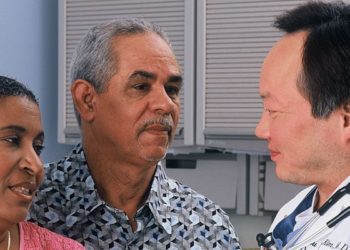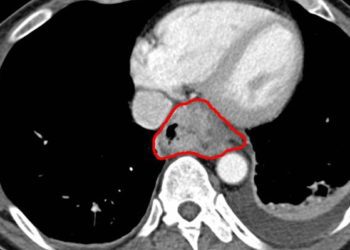Treating proximal humeral fractures: Reverse shoulder arthroplasty provides superior long term functional outcomes vs. hemiarthroplasty
Jan 10th – At 5 years, patients treated with RSA had significantly better Oxford Shoulder Scores (OSS) than those treated with hemiarthroplasty.
 [tabs tab1=”2MM Rundown” tab2= “2MM Full Report” tab3=”About the Authors”]
[tabs tab1=”2MM Rundown” tab2= “2MM Full Report” tab3=”About the Authors”]
[tab]
Image: CC/J.Heilman
1. Reverse shoulder arthroplasty (RSA) is a successful surgical option for patients with acute proximal humeral fractures requiring prosthetic replacement of the humeral head.
2. At 5 years, patients treated with RSA had significantly better Oxford Shoulder Scores (OSS) than those treated with hemiarthroplasty.
For patients suffering from acute proximal humeral fractures that require prosthetic replacement of the humeral head, RSA is an effective surgical option, providing superior 5 year functional outcomes to hemiarthroplasty. The fact that patients in the RSA group had higher OSS scores despite being significantly older strengthens the merits of this procedure.
This study is limited to a functional evaluation as measured by the OSS, a subjective scoring system. It therefore does not include the objective assessment of range of motion or power which would significantly strengthen the group comparisons. Differences with respect to age, gender, and surgeon case volume may also represent limitations to this study, although each was independently shown not have a significant effect on postoperative OSS.
Click to read the study in the Journal of Shoulder and Elbow Surgery
[/tab]
[tab]
Image: CC/J.Heilman
1. Reverse shoulder arthroplasty (RSA) is a successful surgical option for patients with acute proximal humeral fractures requiring prosthetic replacement of the humeral head.
2. At 5 years, patients treated with RSA had significantly better Oxford Shoulder Scores (OSS) than those treated with hemiarthroplasty.
Primer: Proximal humeral fractures are commonly seen in elderly osteoporotic patients who have suffered a fall. While nondisplaced and minimally displaced fractures can be successfully managed with conservative treatment, more complex fractures may require surgery. If the vascular supply and structural stability of the humeral head cannot be secured via open reduction and internal fixation, the humeral head is at risk for osteonecrosis. In these cases, the preferred surgical options include hemiarthroplasty and reverse shoulder arthroplasty(RSA). Hemiarthroplasty involves removal of the humeral head which is then replaced by a prosthesis. Alternatively, in RSA a metal sphere is implanted into the glenoid socket and a plastic cup is attached to the proximal humerus, effectively “reversing” the ball and socket joint. This study compares the five year functional outcomes of these two procedures for the treatment of complex proximal humeral fractures.
Background Reading
- Hemiarthroplasty for Three- and Four-part Proximal Humerus Fractures
- Arthroplasty for Fractures of the Proximal Part of the Humerus
This [Retrospective Case Control] study: looked at patients from the New Zealand Joint Registry who were treated for acute proximal humeral fractures between 1999 and 2010. 55 primary RSA patients and 313 primary shoulder hemiarthroplasty patients were evaluated. Post-operative functional outcomes were assessed at 6 months and 5 years by the Oxford Shoulder Score (OSS). Patients in the RSA group were significantly older (79.6 vs 71.9 years) and had a greater proportion of females (92.7% vs 78.0%) than the hemiarthroplasty group. Although the groups showed no difference in OSS at 6 month follow-up, RSA displayed a significantly higher OSS at 5 years of 41.5 vs 32.3. Surgeon case volume was significantly higher for the RSA group, although no difference was found in operative time, revision rate, or mortality.
In sum: For patients suffering from acute proximal humeral fractures that require prosthetic replacement of the humeral head, RSA is an effective surgical option, providing superior 5 year functional outcomes to hemiarthroplasty. The fact that patients in the RSA group had higher OSS scores despite being significantly older strengthens the merits of this procedure.
This study is limited to a functional evaluation as measured by the OSS, a subjective scoring system. It therefore does not include the objective assessment of range of motion or power which would significantly strengthen the group comparisons. Differences with respect to age, gender, and surgeon case volume may also represent limitations to this study, although each was independently shown not have a significant effect on postoperative OSS.
Click to read the study in the Journal of Shoulder and Elbow Surgery
By [CC] and [AH]
© 2013 2minutemedicine.com. All rights reserved. No works may be reproduced without written consent from 2minutemedicine.com. Disclaimer: We present factual information directly from peer reviewed medical journals. No post should be construed as medical advice and is not intended as such by the authors or by 2minutemedicine.com. PLEASE SEE A HEALTHCARE PROVIDER IN YOUR AREA IF YOU SEEK MEDICAL ADVICE OF ANY SORT. Content is produced in accordance with fair use copyrights solely and strictly for the purpose of teaching, news and criticism. No benefit, monetary or otherwise, is realized by any participants or the owner of this domain.
[/tab]
[tab]
 Chaz Carrier: Chaz is a 2nd year M.D. candidate at Albany Medical College.
Chaz Carrier: Chaz is a 2nd year M.D. candidate at Albany Medical College.
 Allen Ho: Allen is a 4th year M.D. candidate at Harvard Medical School.
Allen Ho: Allen is a 4th year M.D. candidate at Harvard Medical School.
[/tab]
[/tabs]




